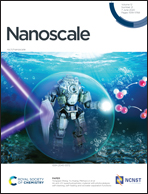Endowing chloroplasts with artificial “cell walls” using metal–organic frameworks†
Abstract
Biological photosynthesis via chloroplasts (CHs) is widely recognized as the most appropriate and effective method to convert solar energy and simultaneously supply nutrition to maintain life on earth. It is of great significance to prepare CH-based biohybrids which not only can artificially simulate the photocatalytic functionality of CH-containing plants and bacteria, but also can be easily prepared, stored for a long period and conveniently utilized when needed. In this work, for the first time, CHs were encapsulated into metal–organic frameworks (MOFs), namely zeolitic imidazolate frameworks (ZIF-8), under very gentle reaction conditions, i.e. in aqueous solution and at room temperature. Without the negative effects of organic solvents and high temperature on synthesis, the obtained CH@ZIF-8 biohybrids not only have shells maintaining the porous structure of ZIF-8, but also well preserve the biological activity of CHs inside. The porous ZIF-8 coating on CHs acts as a “cell wall” to allow mass and energy exchange between CHs and the environment, and protect CHs from microbiological degradation, which significantly prolong the lifetime of CHs in vitro (raised from several days to >300 days). The CH@ZIF-8 biohybrids may have promising applications in “living” artificial leaves and even artificial trees capable of photosynthesis in the future.



 Please wait while we load your content...
Please wait while we load your content...